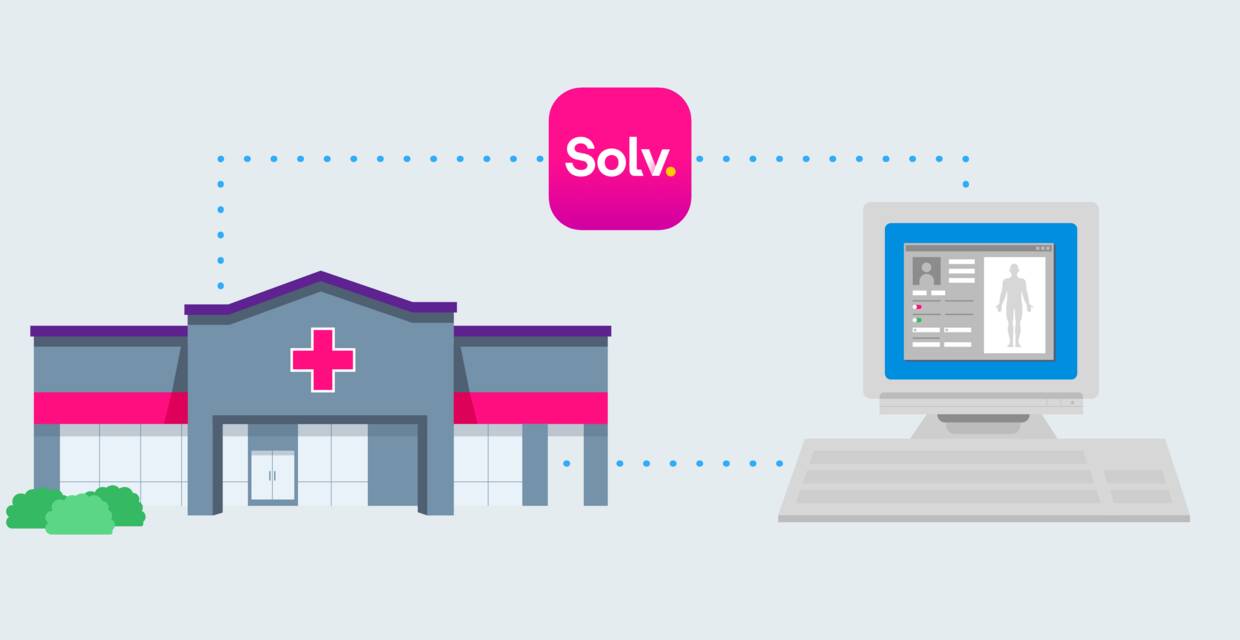Originally published October 2020.
Solv’s Robotic Automation technology opens up closed EHRs and unlocks opportunities for healthcare innovation
Over the past decade, many EHRs have slowly adopted new standards of interoperability, and are now providing open integrations with outside technologies. For those EHRs who haven’t taken action, the 21st Century CURES Act has forced them to become more patient-centric and interoperable. EHRs have traditionally served as a repository of health data with little or no ability for patients to access and utilize their records. In fact, when we started Solv, it was news to me when I learned that EHR vendor priorities had little to do with my patient experience, outcomes and information, and much more to do with the monetization of my visit. Looking back, it’s cute how naive I was, but alas — American healthcare didn’t get to where we are today based on things that make sense!
The good news is increasing EHR interoperability has created opportunities for healthcare providers to modernize their practices with innovative technologies that improve patient experiences and clinical outcomes. Even better, is the impact interoperability has for patients — it gives them more control of their health data and puts them at the center of their care. At Solv, we believe modern healthcare technology companies must provide interoperable and open solutions, and we have pledged to operate an open platform through our Data Connect program.
Unfortunately, many widely used EHR vendors still do not offer modern, interoperable solutions. They intentionally close off their systems to outside technology. In some cases, EHRs will claim they are interoperable but end up charging their customers exorbitant and prohibitive fees to open data connections for integrations. The worst part: there is zero customer or patient justification for the obstruction. It’s protectionist and ultimately works against their core customer. Imagine if Apple only allowed you to use apps built by their software developer. Imagine if Costco only stocked their shelves with Kirkland-branded products for their members. You actually can’t imagine it because it’s so clearly absurd. And yet, here we are in American healthcare.
Health systems, providers and urgent care operators running closed EHRs have been left with fewer choices. Patient engagement suffers, and ultimately, patient experience does too. More and more, we hear from practices that want to move off of their EHR, or use best-in-class technology for patient engagement or telemedicine, but they are locked into a system that has fallen behind and is incompatible with modern technology. The bottom line: It’s time for this antiquated thinking to end and for providers to freely operate in a way that supports patient engagement, patient outcomes and ultimately modernizes practices across the country.
Today, Solv is taking our commitment to interoperability another step forward. We’re proud to announce support for an innovative technology, Robotic Automation, that allows Solv’s software to seamlessly work with legacy EHR systems. If you want to use Solv’s patient experience software to drive a ‘wow’ experience for your patients, but data transfer to the EHR has been holding you back, we’ve fixed that for you. Robotic Automation is included with Solv for no additional fee.
How do Robotic Automations replace the need for a complex EHR integration? It’s simple — we do it by taking on the work your staff would perform transferring data from Solv into your EHR and automating it. This AI-based technology automatically handles the data entry, transferring registration data to the patient record and adding an appointment to the EHR’s schedule. Think of it as a robot that is smart enough to do all of the pointing, clicking, copying and pasting — saving minutes per patient and hours per day that your staff can use on higher value tasks.
The results are powerful. A Robotic Automation can eliminate more than 10 hours of EHR work for a receptionist each week, while helping reduce data errors created by manual entry. We estimate automations will save as much as $12,000 annually per clinic location, while eliminating the need for you to pay unnecessary integration fees to your EHR vendor. The HIPAA-compliant technology is secure, uses end-to-end encryption, and has been proven in many industries to connect modern technologies to out-of-date systems that deprioritize the consumer experience, enabling you to compete in today’s world.

Really, robots do the work! Here’s how.
Robotic process automations, or RPAs, use scripts and algorithms to efficiently and securely automate the work a human would do otherwise. As Gist Healthcare explains:
“[RPA] translates to finding repetitive, often error-prone tasks performed by human staff, and implementing ‘bots’ to perform them instead. The benefit? Fewer mistakes, the ability to redeploy talent to less ‘mindless’ work (often with the unexpected benefit of improving employee engagement), and the potential to capture substantial efficiencies.”
RPA is used across major industries as trusted, secure, and reliable. When COVID-19 brought the airline industry to a halt, more than 120,000 cancellation requests were received by a single major airline during the first few weeks of the pandemic. The solution: an RPA bot that addressed 80% of the requests. In health insurance, RPA is used to optimize claims processing with staggering results, including a 50% reduction in processing costs, a 70% increase in processing speed through automation, and a 60% decrease in error rates. For the healthcare industry at large, research predicts that more than 50% of interactions and processes will become automated throughout the next decade — a trend that will benefit the financial stability, consumer loyalty, and competitive advantage for operations directors who use automation to get ahead.
Robotic Automations can spark innovation in convenient care.
Vendor lock-in is a dangerous position to be in, especially as more healthcare operators look toward technology as a competitive advantage to attract and retain patients. The pitfalls of being locked in are numerous, and many healthcare leaders are making moves to avoid them. For example, rural and urban hospitals alike are turning away from “big box” EHR solutions in favor of more agile tools that prioritize interoperability and integrated care. Robotic automations give providers running closed EHRs a new path to eliminate the risk of falling behind. In fact, Gartner estimates that over the next three years, 50% of healthcare providers will invest in RPA.
With the ability to work 365/24/7, RPA enables flexible, efficient data exchange with legacy technology and is not bogged down by the constraints of off-the-shelf integrations. The benefits of RPA for a practice’s staff are many: saving valuable time, automating EHR work, eliminating double data entry, and reducing tedious pointing and clicking. Requiring very little, if any, internal IT support, an RPA solution is configured to match existing EHR setups and workflows. With encrypted data transfer, the result is secure, customizable, and uncomplicated.
Solv’s continued commitment to interoperability.
We have successfully implemented Robotic Automations at hundreds of urgent care locations running Experity, DocuTAP, and eClinicalWorks. Many of Solv’s urgent care partners both large and small rely on this technology to create a seamless workflow for their operations.
In addition to expanding future RPA offerings, Solv will continue to support direct integrations with open EHRs, such as our integration with AllScripts, AthenaHealth, Epic*, NextGen and dozens more.
One final point to make clear — we are enthusiastic about working with all EHRs on direct integrations through APIs as soon as they choose to make them available for their customers. But we will not wait. By investing in automation, we are taking a stand that urgent care operators and all providers deserve choice and flexibility, and innovation should not be stifled by vendor lock-in. In our commitment to our partners’ success, we believe Robotic Automations can modernize urgent care IT, unlock legacy EHRs, and help our partners compete and thrive in today’s environment by delivering better experiences for their patients.
*Epic is a trademark of Epic Systems Corporation
The third party names and trademarks referenced above are the property of their respective owners. Reference to third party EHR or other vendors here does not indicate endorsement or sponsorship by, or a partnership relationship with, these third parties.



